![]() Download the PDF (852 KB)
Download the PDF (852 KB)
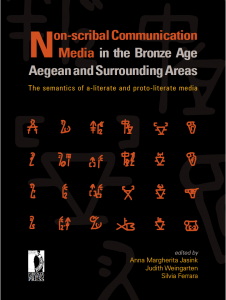 Chapter excerpt from Non-scribal Communication Media in the Bronze Age Aegean and Surrounding Areas: The semantics of a-literate and proto-literate media
Chapter excerpt from Non-scribal Communication Media in the Bronze Age Aegean and Surrounding Areas: The semantics of a-literate and proto-literate media
Edited by Anna Margherita Jasink, Judith Weingarten and Silvia Ferrara
Authors: Denise Schmandt-Besserat and Niloufar Moghimi
Abstract: It is true that there is never just a single piece of information to be obtained from a given artifact1. A simple clay spindle whorl, for example, will tell about the wool or silk thread it produced, but also about the ceramic craft of its time: the quality of clay, the degree of firing, etc. It goes without saying that for semantic objects – objects carrying a meaning – the amount of information that can be retrieved multiplies exponentially.
For example, a cone shaped token, that bore the meaning «one peck of barley», communicates information on economy, administration, society, and cognition. In this paper we identify the information conveyed by a collection of tokens excavated at Tepe Zagheh, Iran.2 We hope that the study will prove helpful to the archaeologists who have the chance of excavating tokens in their own sites.
Tepe Zagheh
Tepe Zagheh, located in the Qazvin Plain of Central Plateau of Iran, exemplifies the important transition between the Neolithic and Chalcolithic Periods, ca. 5300- 4400/4300 BCE3.
About 1000 square meters of the mound have been excavated by the University of Tehran in the course of some twenty seasons of excavations directed respectively by Ezzat O. Negahban4, S. Malek Shahmirzadi5 and Mohammad Saleh Salehi6. Sixteen domestic compounds were exposed7, among which the so-called «Painted Building», a large decorated structure interpreted as a temple8 or meeting hall9 (Fig. 5).
The Token collection
The collection of 238 tokens discussed in this paper were excavated in the seasons of 2011-12 under the leadership of Hassan Fazeli Nashli10. It was the topic of Niloufar Moghimi’s Master Thesis at the Department of Archaeology of the University of Teheran11. We have not included the tokens recovered in previous campaigns, although some of them are illustrated in Figs 1, 2 and 3. The assemblage includes seven token types in fifteen subtypes as shown in Table 1.
| Cones | 94 | Small isosceles: 49 | Large isosceles: 5 | Equilateral: 13 | Truncated: 11 | Round apex: 8 | Long: 8 |
|---|---|---|---|---|---|---|---|
| Spheres | 84 | Plain: 43 | Half: 41 | ||||
| Disks | 31 | Flat: 23 | Lenticular: 8 | ||||
| Tetrahedrons | 2 | ||||||
| Ovoids | 14 | ||||||
| Quadrangles | 9 | Flat: 1 | Cubes: 8 | ||||
| Hyperboloids | 4 |
None of the tokens from Zagheh were recovered in situ. As it is generally the case for accounting records of all periods, including the cuneiform economic tablets, the tokens were seemingly routinely discarded after the deals they featured were settled. 206 tokens, or the bulk of the collection, were recovered in a trash deposit (garbage) where they were mixed with ashes and burned mud-bricks.
Unfortunately, no organic material was present that could identify the season when they were discarded12. A far smaller number, 32 tokens, were recovered in a large excavated section (1050 m2) of a residential area, where they were not associated with any particular architectural features13.
The Token system
Tokens used for counting goods appeared in the ancient Near East at the same time as agriculture ca. 7500 BCE14. The artifacts can be regarded as a hallmark of the Neolithic and Chalcolithic periods since there were no tokens during the preceding Paleolithic and Mesolithic periods and they disappeared during the following Bronze Age. The Paleolithic and Mesolithic nomadic bands had no use for counting since the hunters distributed their game according to a tradition that attributed each morsel to one particular kin. In the Bronze Age, tokens were replaced by writing – which itself evolved from tokens.
As decoded by the earliest written tablets of 3100 BCE, each token shape was the symbol for a particular commodity15. Isosceles cones, (Fig. 1) spheres (Fig. 2) and disks (Fig. 3) stood for various measures of cereals16.
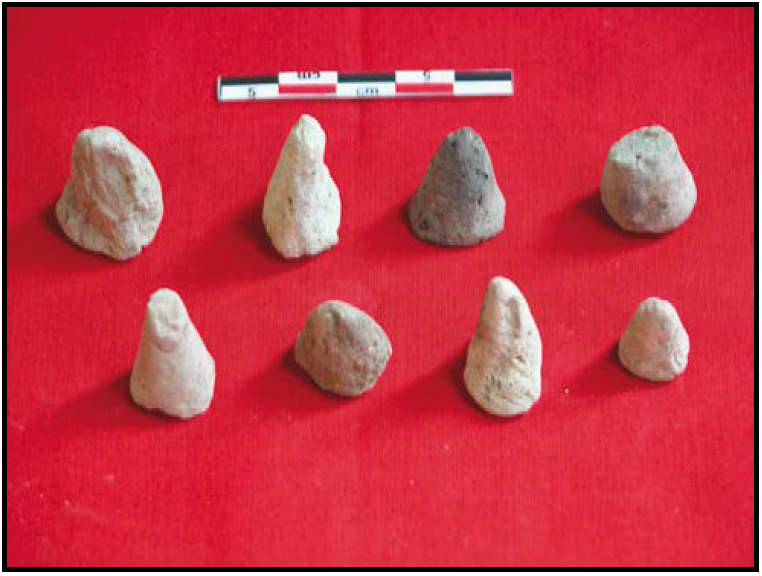
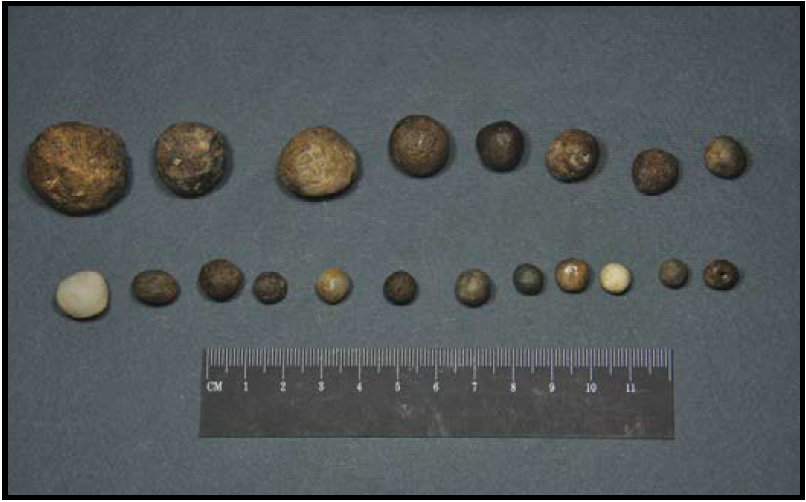
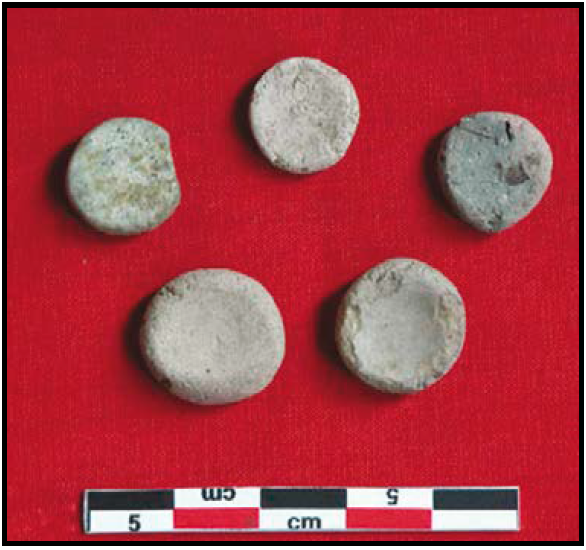
A small cone and a small sphere were respectively equivalent to one peck and one bushel of cereals. A large cone, a large sphere and a flat disk stood for larger measures, perhaps corresponding to one bag (3 bushels), one cauldron (36 bushels) or one load (40 bushels). Ovoids represented jars of oil; each lenticular disk stood for «a flock» of domesticated small cattle (10?)17, while tetrahedrons were units of work. The remaining 2 types and 5 subtypes are still unidentified.
Economy
Because they were not recovered in situ, the tokens of Tepe Zagheh do not represent meaningful accounts such as the product of a harvest or the amount of a contribution. Nevertheless, the collection makes it clear that a number of different goods were managed in substantial quantities at the site. The fact that 102 of the 238 tokens referred to grain shows that cereals constituted the most important resource of the community. The quantities of grain represented by the collection can tentatively be computed as follows18:
43 spheres
5 large cones
23 flat disks
43 bushels
5 sacks (?) = 15 bushels of grain
23 loads (?) = 184 bushels of grain
The cones, spheres and disks, which represented a range of units – from very small to very large or from a peck to a load – show that these tokens stood for an everyday commodity. It is therefore reasonable to assume that Tepe Zagheh’s major crop was barley, the all-time common staple of the ancient Near East.
The 4 ovoid tokens, standing for jars of oil,19 imply that sesame seeds, which produced oil, were another significant crop.
The 8 lenticular disks representing 8 «flocks» of domesticated sheep or goats (80?) show that the Tepe Zagheh economy also relied on livestock20. The fact that the animals were counted by ten suggests sizeable herds.
The 8 quadrangular tokens are particularly interesting because these shapes never appear in any other Neolithic or Chalcolithic token assemblages of Iran, and for that matter anywhere else in the ancient Near East. The quadrangles may therefore be expected to stand for products that were unique to the site.
Finally, the 2 tetrahedrons differed by not referring to foods, but to units of service or labor21. They suggest that individuals were compensated for public works such as, for instance, irrigation works.
It is likely that the still unidentified tokens stood for typical Neolithic crops of the region, such as wheat, emmer, lentils, chickpeas, horse beans, vetches, or flax.
In sum, the variety and percentage of tokens included in the collection disclose that Tepe Zagheh’s economy was based on as many as 15 commodities, among which cereals, oil and livestock were the most important. Perhaps more significantly, the token collection highlights that the bulk of the goods counted consisted of non-perishable goods. This illustrates how the settled agricultural communities accumulated and stored food in order to survive during the lean season.
The administration
The relatively numerous tokens indicating substantial quantities of non-perishable goods, and sizeable numbers of animals on the hoof, do not seem to correspond to the accounting of single households. The large amounts rather point to a larger operation. In particular, the many tokens representing big units of cereals suggest the presence of an organization in charge of accumulating, storing and managing communal goods.
The large volume of non-perishable goods represented by the cones, spheres and tokens tell how the early farmers banded together to face the rigors of the winter by accumulating food reserves. The management of agricultural crops meant long term planning from sowing to harvesting and redistribution. In order to evaluate amounts of goods, budget their use and control their movement at each step of the way, the budding communal administration needed new technologies for counting and measuring. By their mere presence, the tokens acknowledge the creation of a system of counters for counting and accounting. By the symbolism attached to the shapes of the cones, spheres and disks, the tokens signal the existence of a metrological system covering a wide scale of units. It is interesting to note that the seals, which were so important in the following Bronze Age administration, were not yet part of the Tepe Zagheh accountants’ tool kit.
Although archaic, the token system was able to carry out the multiple operations necessary for the management of a communal economy:
- Establish the amounts of goods or labor each household was to contribute to the community.
- Control the actual delivery of goods.
- Supervise the protection of the reserves from weather, pests and thieves and, finally,
- Oversee the redistribution. Without tokens such communal management could not
The «Painted Building» may add more information on the emerging token administration. It certainly is not by chance that the plan of this remarkable structure at Tepe Zagheh was similar to that of the 4th millennium Near Eastern «temples»22. Like the Uruk temples, the Painted Building had a large central hall with a number of adjacent small rooms on each side23 (Fig. 5).
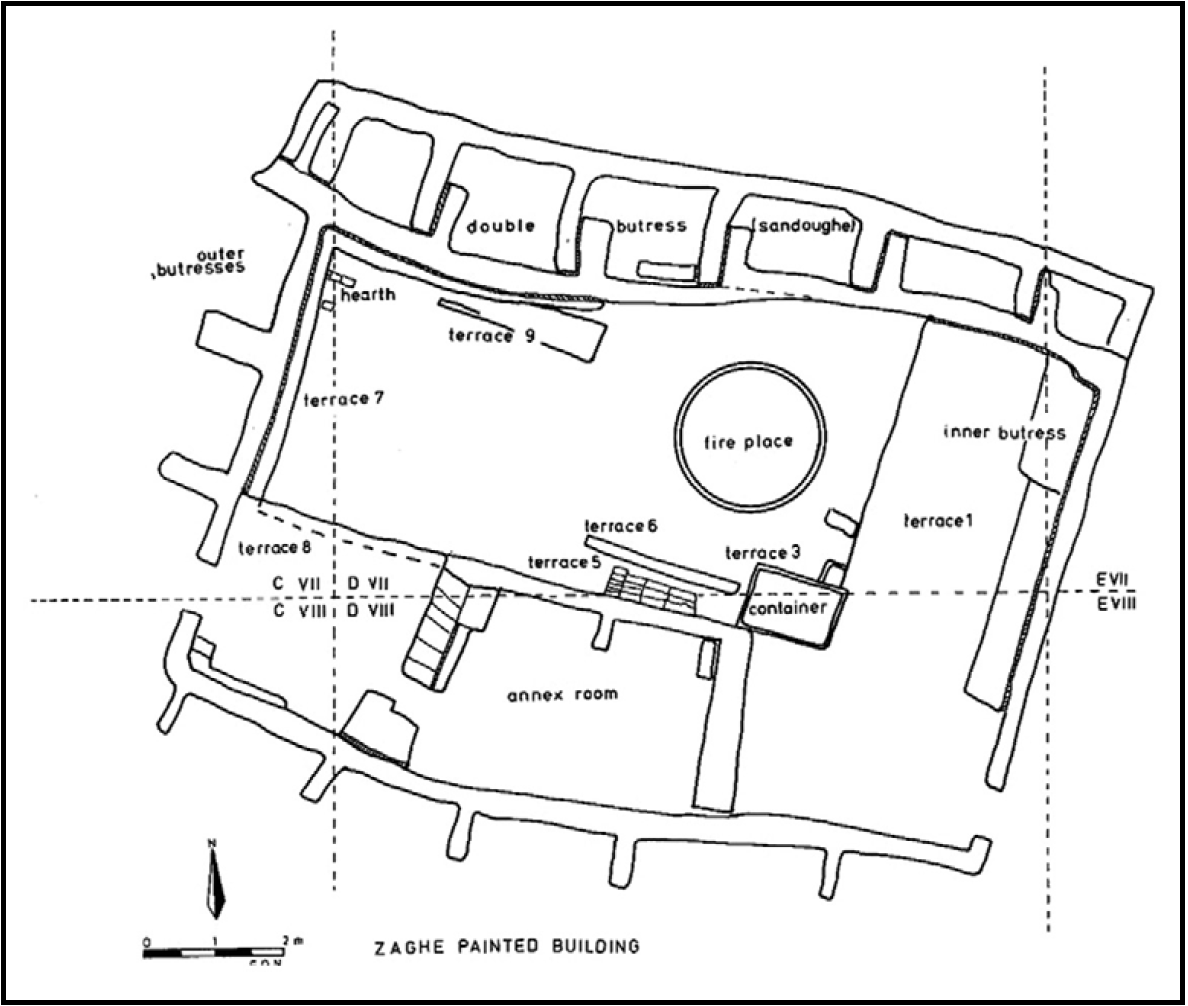
Like the Tell Uqair temple24, it was decorated with bold designs painted in red, white and black. In 3100 BCE, it was in such «temples» that the first scribes registered on tablets the in kind contributions delivered by citizens. It is likely that, 2000 years earlier, the Tepe Zagheh Painted Building fulfilled exactly the same function. Its central hall featured platforms upon which the farmers unloaded the heavy sacks of grain and the jars of oil levied for the community, which the administrators checked by matching them with tokens. Later, the dry goods were stored in the 6 small rooms situated to the north, where they were well protected from the sun. The sheep and goats were kept in the pen located on the east side. Finally, in the rooms oriented towards the south to be warm in winter, tokens were made, budgets were established and accounting took place.
The fact that Tepe Zagheh was not unique in using tokens, but that the same artifacts, used for the same function, were ubiquitous throughout the Neolithic Near East from Syria to Afghanistan, speaks for the emergence of a far reaching phenomenon of food administration in the 8th millennium BCE. The fact that tokens remained in use for 4000 continuous years until they were replaced, without hiatus, by writing in the city state administration, shows the direct link between the Neolithic and the Bronze Age administrations. Tokens, as well as the «temple» architecture, prove that, what is known as the «Near Eastern economy of redistribution» had its roots deep in prehistory. It is likely that, starting with the very beginning of agriculture, farmers organized themselves to contribute a given amount of their crops to be redistributed at a later date. The redistribution could either take the form of food rations in times of need, or of communal festivals deemed to propitiate the gods25.
Society
Forensic science may one day say a great deal about the Neolithic administrators who left their finger prints on tokens while the clay was soft. For now we can say that counting being a new and difficult technique, only few individuals had the expertise to take on the responsibilities of managing the common goods and derive prestige and power from it. The tokens therefore speak of the rise of a new Neolithic elite of administrators based on mental capacities.
We may assume that the first public administrators were farmers, like everyone else in the community, since there were no visible status symbols in the village. For instance, three of the sixteen mud brick compounds show only minimal differences in size and decoration26. Likewise, none of the burials located below the house floors, displayed any particular sign of wealth27. There were also no seals to single out particular individuals or indicate a hierarchy. In fact, because counting was a novel technology, the new elite may not have been recruited among the elders, but rather among the most gifted sons of farmers. It is also not inconceivable that women could manage the village assets. After all, Nisaba, the patron of the Sumerian scribes, was deemed to have invented writing because she was in charge of the gods’ granaries. The idea of female Neolithic/ Chalcolithic managers may even be supported by the fact that eight burials, located close to and oriented towards the Painted Building, were those of women (Fig. 4)28. The female graves also stand out by yielding strands of agate and turquoise beads.
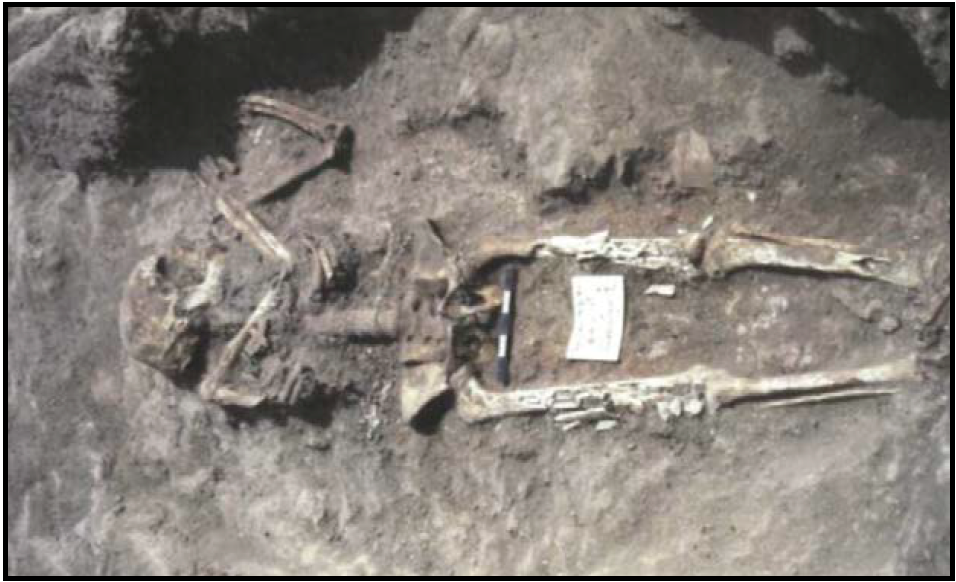
The tokens show that, in prehistoric societies, leadership was acquired through socio- economic prowess. The Paleolithic chief was the capable hunter, who brought the most game to camp; the Neolithic leaders were the smart managers who drew power from controlling the communal resources. However, the Neolithic elite was in sharp contrast with the preceding Paleolithic leadership. The Paleolithic chiefs relied on their physical dexterity to catch their preys, whereas the Neolithic leaders depended on brain power to perform additions, subtractions, multiplications and divisions. Hunting demanded quick action, but management implied reflection and a long term vision. The hunter relied on his bow; the Neolithic manager on tokens. The hunters most desired quality was generosity; that of the Neolithic managers was fairness. They were expected to levy reasonable contributions and to redistribute the goods equally. Since neither the Paleolithic nor the Neolithic leadership claimed the right of using force against their peers, both had to rely on their charismatic personalities to achieve their goals.
As farming advanced and population multiplied, the economy of redistribution gained in volume and importance. The managers were confronted by ever increasing amounts of goods to manage, and compute. The challenges improved their cognitive skills and at the same time arithmetic and mathematics developed.
Cognition
Counting with tokens was performed in the most basic and simplest way possible: in one- to-one correspondence. In other words, each unit of goods to be recorded was matched with a token: two jars of oil were shown by two ovoids and ten jars of oil by ten ovoid tokens. The archaic principle of one-to-one correspondence was inherited from as far back in the past as the Paleolithic period. However, whereas counting during the Paleolithic meant only matching a set of items with pebbles while just repeating «and one more», Tepe Zagheh had mastered cardinality.
Cardinality is the ability to assign number words – for us, for example, we count
«one, two, three…» pointing to each item of a collection, with the final number word of the series representing the number of the set. Tokens such as the lenticular disk, which stood for «10 sheep», provide evidence that Tepe Zagheh had acquired the principle of cardinality29. It was, of course, an extraordinary cognitive step since cardinality meant the beginning of arithmetic. Cardinality brought also a considerable economy of notation: 30 sheep were expressed by 3 tokens instead of 30.
On the other hand, the multiplicity of token shapes illustrates that Tepe Zagheh had no abstract numbers such as «one», «two», «three…» that could be used indifferently to count animals, jars of oil or measures of grain30. Instead, the fact that sheep were counted with disks, jars of oil with ovoids and small measures of grain with cones denotes concrete numbers – numbers applicable to a single category of goods. The tokens of multiple shapes, each used exclusively to count one product, mirror a time when, at Tepe Zagheh, sheep were counted with special number words, while jars of oil were counted with a different numeration. This archaic way of counting, prior to the acquisition of abstract numbers, is referred to as concrete counting.
Tokens provide a unique insight into the stage of cognition of the individuals who used them. They demonstrate that during the 8-5th millennium BCE, numbers were not conceived abstractly. The tokens thus corroborate Luria’s, Mc Luhan’s, Ong’s and Goody’s ideas who characterize the preliterate societies as shunning abstraction31. There was no such concept as oneness, twoness and threeness. Instead, plurality was still viewed as series of separate concrete sets. At the same time, the Neolithic tokens highlight the extraordinary contribution of the Bronze Age accountants who achieved to transcend the concrete world and work in abstraction.
Conclusion
The collection of tokens of Zagheh has much to say to the attentive archaeologist. By the symbolism attached to their shapes, by their number and frequency, the 238 tokens of Tepe Zagheh disclose the types and quantities of foods generated and accumulated to survive over the winter months by a typical Iranian Neolithic/Chalcolithic village.
By their wide extension and by their endurance over 4000 years, the tokens acknowledge the emergence of an archaic but efficient administration responsible for managing stored foods in early agricultural communities throughout the Near East. More importantly, the tokens speak of the relation between the management of agricultural communal goods and the invention of counting and metrology. And as agriculture progressed and population expanded, the accumulation of unprecedented wealth challenged the human brain to compute larger and larger numbers and greater and greater quantities. It was the steady progress of these new mental processes that led to the development of arithmetic, writing and civilization.
Bibliography
Devlin, K., 1991. Logic and information, Cambridge: Cambridge University Press.
Malek Shahmirzadi, S. 1977. Tepe Zagheh: a Sixth Millennium B.C. Village in the Qazvin Plain of the Central Iranian Plateau, University of Pennsylvania: PhD Dissertation.
Malek Shahmirzadi, S. 1979. A Specialized Housebuilder in an Iranian village of the VIth Millennium BC, Paléorient 5: 183-192.
Malek Shahmirzadi, S. 1990. Private Houses at Zagheh: A Sixth Millennium BC village in Iran,
Bulletin of the Ancient Orient Museum XI: 1-25.
Malek Shahmirzadi, S. 1999. Prehistoric Iran: Iran from the Earliest Times to the Dawn of Urbanism, Tehran: Research Department of Cultural Heritage Organization Press (in Persian).
Moghimi, N. 2013. An Archaeological Study and Analysis on Tokens of Tepe Zagheh and their Role in Human Societies of the Prehistoric Period in the Qazvin Plain, M.A. Thesis. Prehistoric Archaeology of Iran, Department of Archaeology, Faculty of Literature and Humanities, University of Teheran, Iran (in Persian).
Moghimi, N. 2015. An Archaeological Study on Accounting Systems in Prehistoric Human Societies of the Qazvin Plain: The Case of Tepe Zagheh, Journal of Archaeological Studies 7/1-11: 127-146 (in Persian).
Moghimi, N., Fazeli Nashli, H. 2015. An Archaeological Study of the Tokens from Tepe Zageh, Qazvin Plain, Iran, International Journal of the Society of Iranian Archaeologists 1/2: 30-42.
Mollasalehi, H., Mashkour, M., Chaychi A., Naderi, R. 2006. A Chronology of the Prehistoric Site of Zagheh in the Qazvin Plain, 2004/1383 A.H, Bastanshenasi 2-3: 26-46 (in Persian).
Lakoff, G., Nunez, R.E. 2000. Where Mathematics Comes From, New York: Basic Books.
Negahban, E.O. 1973. Preliminary Report of the Excavation of Sagzabad, 1970 Season, Marlik
1: 1-23 (in Persian).
Negahban, E.O. 1977. Preliminary Report of the Qazvin Expedition: Excavations at Zagheh, Ghabristan and Sagzabad (1971–1972), Marlik 2: 26-44 (in Persian).
Negahban, E.O. 1979. A Brief Report on the Painted Building of Zagheh (Late 7th to Early 6th Millennium BC), Paléorient 5: 239-250.
Nissen, H., Heine, P. 2009. From Mesopotamia to Iraq, The University of Chicago Press, Chicago.
Nunn, A. 1988. Die Wandmalerei und die Glasierte Wandschmuck im Alten Orient, Brill, Leiden.
Ong, W.J. 1982. Orality and Literacy, Methuen, London.
Pollard, M.A., Davoudi, H., Mostafapour, I., Valipour, H.R., Fazeli Nashli, H. 2012. A New Radiocarbon Chronology for the Late Neolithic to Iron Age on the Qazvin Plain, Iran, Humanities 19-3: 110-151.
Pollard, M.A., Fazeli Nashli, H., Davoudi, H., Sarlak, S., Helwing, B., Saeeidi Anaraki, F. 2013. A New Radiocarbon Chronology for the North Central Plateau of Iran from the Late Neolithic to the Iron Age, Archäologische Mitteilungen aus Iran und Turan (AMIT) 45: 27-50.
Salehi, M.S. 1997/1376. The Probability of the Existence of Counting Objects at Tepe Zagheh, Proceedings of the Archaeological Symposium-Susa (Spring 1373 A.H./1994) I, Tehran: ICHTO: 249-253 (in Persian).
Schmandt-Besserat, D. 1992. Before Writing, Austin: The University of Texas Press.
Schmandt-Besserat, D. 1996. How Writing Came About, Austin: The University of Texas Press.
Schmandt-Besserat, D. 2001. Feasting in the Ancient Near East. In: M. Dietler, B. Hayden (eds.) , Feasts, Archaeological and Ethnographic Perspectives on Food, Politics, and Power. Washington D.C.: Smithsonian Institution Press: 391-403.
Schmandt-Besserat, D. 2016. Tokens, http://sites.utexas.edu/dsb.
Talai, H. 1999. Funeral Rites at Zagheh: a Neolithic Site in the Qazvin Plain, Iran, Documenta Praehistorica 26: 15-21.
Wright, H.T., Miller, N.F., Reding, R. 1980. Time and Process in an Uruk Rural Center. L’Archéologie de l’Iraq du Début de l’époque Néolithique á 333 avant notre Ère, Paris Colloques Internationaux du CNRS: 265-284.
1 Devlin 1991: 16.
2 Moghimi 2015.
3 Fazeli Nashli et alii 2005: 73; Pollard et alii 2012: 120; Pollard et alii 2013: 45, table 9; Mollasalehi et alii 2006: 33-34.
4 Negahban 1973: 15; Negahban 1977: 41-42.
5 Malek Shahmirzadi 1977: 10-12.
6 Salehi 1997: 250.
7 Malek Shahmirzadi 1979: 183.
8 Negahban 1979: 250.
9 Talai 1999: 16.
10 Moghimi and Fazeli 2015.
11 Moghimi 2013.
12 Wright, Miller, Reding 1980: 277.
13 Malek Shahmirzadi 1977: 12.
14 Schmandt-Besserat 2016: http: sites.utexas.edu/dsb.
15 Schmandt-Besserat 1992: 137-142; 1996: 63-68.
16 Schmandt-Besserat 1992: 150-151; 1996: 80-81.
17 Schmandt-Besserat 1992: 152; 1996: 82-83.
18 Schmandt-Besserat 1992: 150-151; 1996: 80-81.
19 Schmandt-Besserat 1992: 144, 194; 1996: 70, 120-121.
20 Schmandt-Besserat 1992: 151-152; 1996: 181-183.
21 Schmandt-Besserat 1992: 150; 1996: 79.
22 Negahban 1979..
23 Nissen and Heine 2009: 24, fig. 15.
24 Nunn 1988: fig. 52.
25 Schmandt-Besserat 2001: 399-401.
26 Malek Shahmirzadi 1979: 187-191.
27 Malek Shahmirzadi 1990: 8-9; 1999: 334-335.
28 Talai 1999: 16-17.
29 Lakoff and Nunez 2000: 54-55.
30 Schmandt-Besserat 1996: 114-116.
31 Ong 1982: 31-56.
Page last updated: 2/24/18